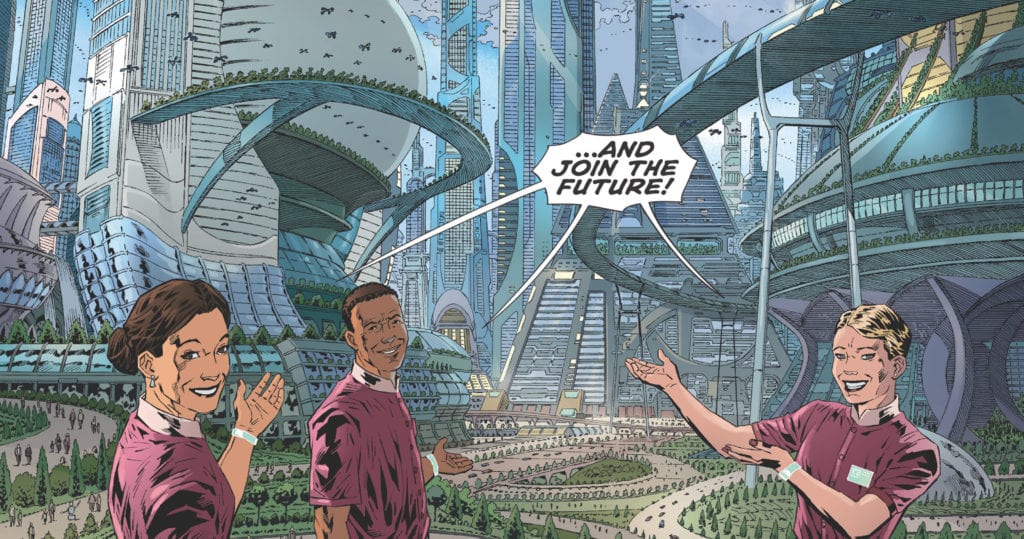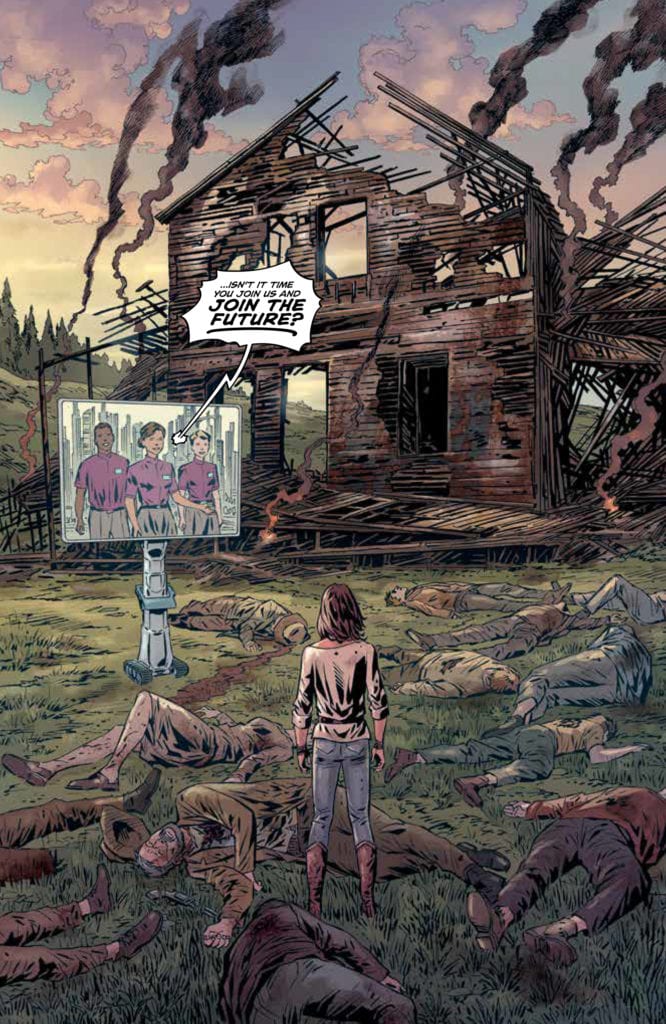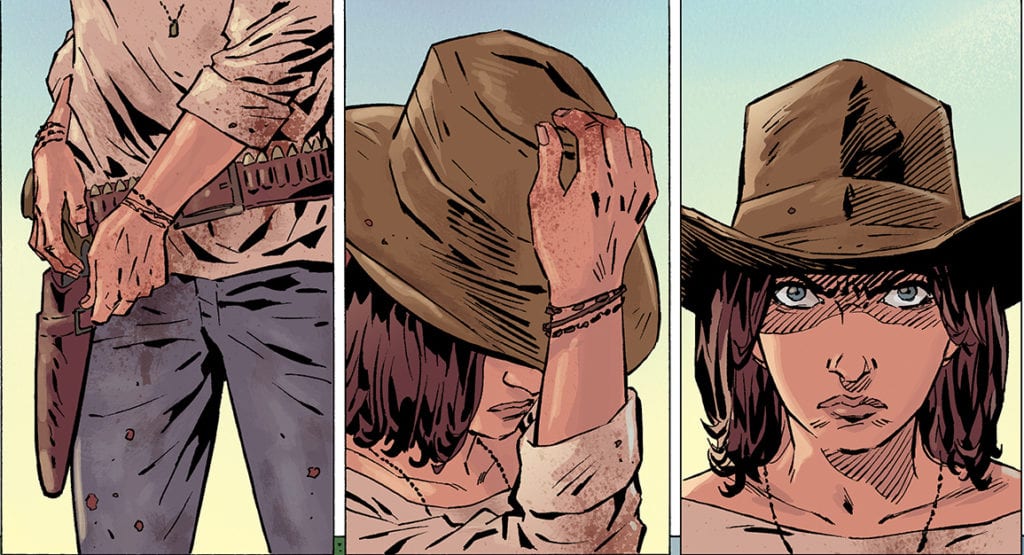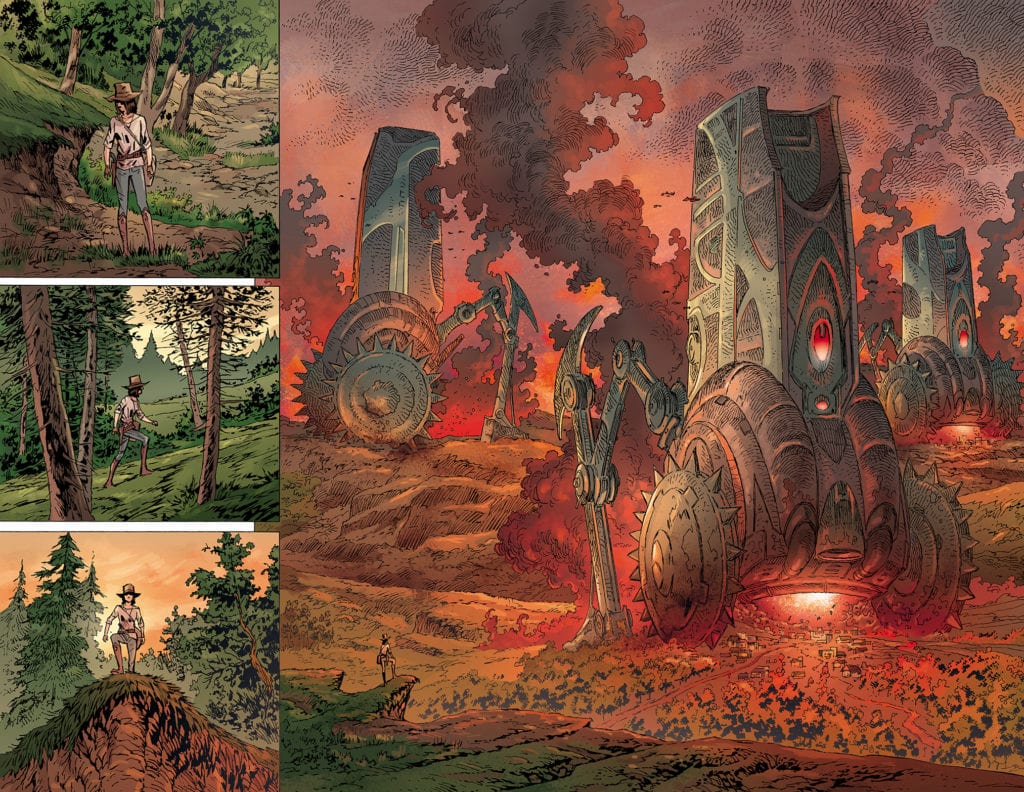The trade paperback collecting the entire series of JOIN THE FUTURE from AfterShock Comics hits your local comic book shop on January 6th. Writer Zack Kaplan joined Monkeys Fighting Robots to reflect on the series and take a deep dive into some of the meaning in the pages.
About JOIN THE FUTURE:
The Future. Ultra-modern megacities reward millions of their citizens with a completely funded life, with every need met, from food to housing and healthcare, in order to compete in an economic power struggle in which population is key.
But a few rural residents still cling to their independence in what last American small towns are left. When a nearby megacity pressures the people of a small town to join up or else, a young teenage girl named Clem will learn how far she’ll go to defend her principles.

Enjoy The Zack Kaplan Interview Below:
MFR: JOIN THE FUTURE is published by AfterShock Comics; from a creator’s perspective, what are they doing right as a publisher?
KAPLAN: Where to begin! I think AfterShock has a sharp eye for rising talent and creators with something interesting to say, and they don’t seem to be afraid to tackle interesting concepts and stories. Piotr, Brad, Hassan, and I were very grateful to bring JOIN THE FUTURE to their library. They instantly got our epic vision for this grand and dramatic sci-fi western, they gave us the freedom to tell the story the way we wanted, and they supported us all along the way. They have a very hardcore group of readers who know that if it’s an AfterShock comic, it’s most likely going to blow you away. I wanted to work with AfterShock because I was a fan before I was an ASC creator.
MFR: You mentioned that the GOONIES was a huge influence on THE LOST CITY EXPLORES. What are the cinematic influences for JOIN THE FUTURE?
KAPLAN: JOIN THE FUTURE takes place in two worlds, a futuristic one and a Western one. In fact, that is the premise of the conflict in the series, how the hi-tech future dominates the rural countryside. Initially, I looked for film and TV references that explored a futuristic story with Western vibes, but I was hard-pressed to discover something that didn’t lean into fantasy, cyberpunk, steampunk, or comedy. Hit the same roadblock in comics. So, I actually leaned on Westerns. They didn’t have to have young female protagonists, although TRUE GRIT was one key landmark. THE GOOD, THE BAD AND THE UGLY, or FIST FULL OF DOLLARS helped me capture the spaghetti western atmosphere, and the first Season of THE MANDALORIAN was a nice touchstone for more grounded sci-fi Western. But JOIN THE FUTURE definitely was a mash-up of many different cinematic touches.

MFR: This is your second series with AfterShock; what did you learn from working on THE LOST CITY EXPLORERS that you could apply to JOIN THE FUTURE?
KAPLAN: In retrospect, THE LOST CITY EXPLORERS was an ambitious title for me because it was a very fast-paced adventure with a lot of world-building and a full ensemble of characters, and I wanted to spend quality time with each and every character. So, when it came time to develop and design JOIN THE FUTURE, I made the choice to focus on one heroine, our headstrong Mayor’s daughter, Clementine Libbey, and spend a lot more time with just her. I wanted to find quiet moments, and really let her emotional story breathe, so that readers could connect with her, care about her. That was where the heart of the story was for me. Stripping back plot and world, and putting character at the foreground: that was my goal for this series.
MFR: JOIN THE FUTURE is very intense. Can you talk about how you paced out the book?
KAPLAN: Spoiler Alert on this one! I knew that since it was a revenge story, the bulk of the story was going to be Clementine’s journey to arm herself, receive the proper training, and launch her retribution. The first act was a delicate dance where we had to see the allure of the future city, then appreciate the subtle intimacy of Clementine’s small-town world, then destroy it all with the attack. That heavy series of gut-punches as she loses people she loves, and then her community allowed us to go without any major action for a bit. But because Clementine is training and finding her way in the world, it was important to juxtapose those calm moments with some very intense action. It also helped to set up the feeling that Clementine is up against the impossible. She can’t stop these high-tech lawmen. Even one gives her a tremendous amount of trouble. But in the end, it’s a classic western, and the third act climax ends in the streets, at high noon, with some wins and losses.

MFR: What elements make up Clementine Libbey?
KAPLAN: The world is supposed to follow a code. A code of morality, of decency, and most of all, independence. Clementine has grown up her whole life learning from her father and her town to respect one’s ability to be independent from technology and controlling forces. She hasn’t even understood these lessons until she’s confronted in this particular moment. With such a spirited willpower, she’s determined to do whatever it takes, from using her ingenuity to her resilience, to preserve against her foes. She was by far the best character I’ve had the pleasure of writing and she was a joy. She even surprised me sometimes with her choices, as I discovered along the way she didn’t even want to use a hi-tech gun to combat her antagonists. She has a grit like no other.
MFR: Content and storytelling are everywhere; is it getting harder to create a lead character that feels original? Or do you let the overall narrative create the originality?
KAPLAN: Sure, if you have a unique and original world or backdrop, it can easily make a typical story or a familiar character feel fresh or new. But here’s a secret. Readers crave truth more than newness. In my opinion, when readers pick up a story, no matter what grabbed their attention, if they find the story to be authentic and the character dilemma to be honest and compelling and surprising, they will accept any familiarity. That character’s story will become iconic and original. When I write, I focus on making the character’s emotions authentic and their drama convincing. And a dynamic world or high concept hook doesn’t hurt.
MFR: JOIN THE FUTURE engages in a conversation about compromising morals for survival. The reflection of our current time is in your face. I felt self-doubts and unanswered questions with the series. Do you think about the conversations you might inspire when tackling a series like JOIN THE FUTURE?
KAPLAN: It is interesting, because I first embarked on this idea years ago, as an abstract exploration of how technology is affecting us. And I always wondered in future stories what happens outside the megacities to the rest of the world. That was coupled with stories I read about declines in small-town America. Then, the series came out at a time when our country was very polarized and some elements in the series, like city v country, or small-town independence, took on all new meanings. I was intending to make a more timeless series, no about red states or blue states, but the ongoing evolution of the human state. But it was my intention to make readers think, and to offer an open-ended conversation without answers. What do we do as a society when the futuristic technology surrounds us? How do we hold on to our self-sufficiency or life’s simplicity or our ideals? I don’t think that technology or progress is bad (I love my tech) and I don’t think small towns are bad (I grew up in an Iowan town years ago). I just think sometimes we find ourselves immersed in our own futures, and before realizing how we got there, we realize we lost something. A little privacy. Something that was pretty to look at, like the stars. Maybe our innocence, which can be worth losing in the long run. Is it good or bad? The reader can decide. So, yes, I do hope the series inspires positive big picture conversations without drawing any direct modern connections too much.

MFR: Do you have a favorite page from the first five issues, and if so, why?
KAPLAN: The double-page spread when Clementine first sees the machines. In this future, the City is using terraforming machines to repurpose abandoned towns and transform them into natural preserves. Sounds nice! But it’s a jarring picture of how technology is obliterating the past without thought, a hammer rather than a scalpel. And for Clementine, it’s an existential threat to the world she has known as a child. The spread required a lot of chaos, dominance and power. Piotr Kowalski, the brilliant artist of the series, and Brad Simpson, the unreal colorist, manage a lot in the book. Glistening future cities, earthy forests, slick weapons and heartfelt characters. Hassan Otsmane Elhaou, our fantastic letterer, also flits through these varying landscapes and elements with ease, making the letters a joy to read. But this double-page spread was an ambitious order. And of course, they all nailed it. It’s hard to look at this double and not feel Clementine’s helplessness, and at the same time, want to see her take down these machines.
MFR: The color work by Brad Simpson on issue four is very impressive. Did you have conversations with the creative team about thematic elements?
KAPLAN: Brad Simpson is one of the best working colorists in the game right now. He’s that Zoolander hot. The guy does Coffin Bound, Crone, Wellington, Black Stars Above and this one, to name a few, all in the same year. We absolutely had conversations about the theme and the tones. We wanted white skies for the future city, not blue, because white signals an emptiness. We opted for muddy tones in the town, to leave it stuck and heavy. After the initial talks, Brad understood the story and he brought an incredible instinct to the colors and the palette. It’s a gorgeous looking book.
MFR: Will we ever see inside a Megacity?
KAPLAN: Hahaha, why? If you’ve read the opening five pages, you’ve seen our Megacity offer you and all readers and rural residents a promotion like no other, a city that can solve all of your problems. And if you think it’s true, that a megacity of technology that dispenses a fully supported life is the utopia it promises to be, then you have already seen all you need to see. They got you! But if you want to verify what you secretly suspect, that it’s not all it’s cracked up to be, that there is some flaw in its design, well, let me ask you? Why can’t you trust your own instinct? You really want to tempt fate just to know if you are right? Will we see inside that Megacity? The answer is – I don’t know. Perhaps, Clementine will ride again, and if she does, she might make the same mistake and go to that city to tempt fate, pit her morals and values against the allure of the future once again. But perhaps she’ll survive in the countryside, a legend to all of us who now and then try to resist aspects of the future. Time will tell. If you want more, let AfterShock and the creative team know.
MFR: Thank you for your time and best of luck with JOIN THE FUTURE.
KAPLAN: Thank you! Find me on social media: @Zackkaps and let me know what you think!

